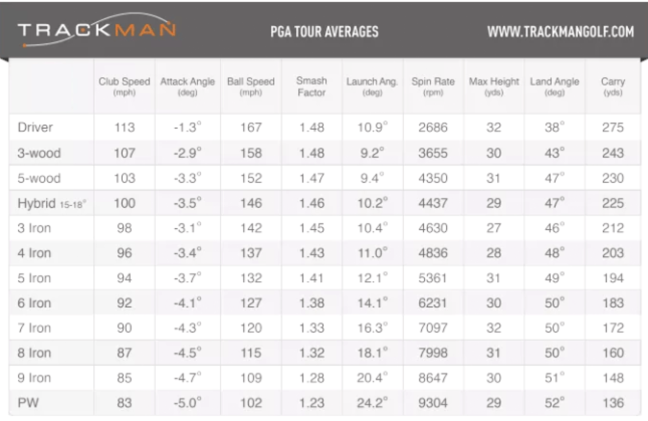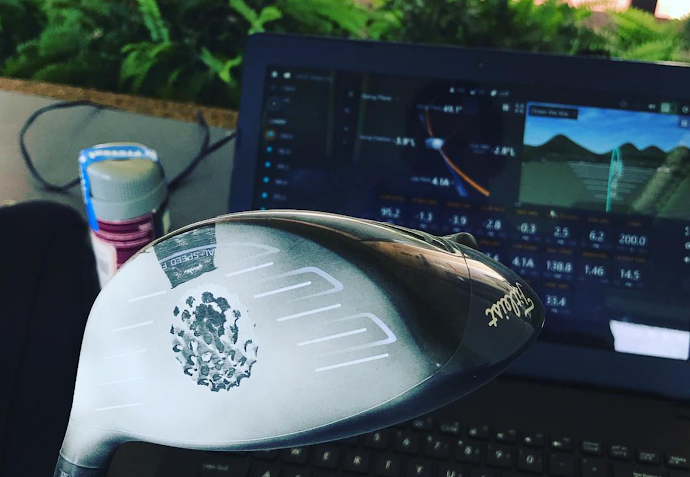How to Get Better at Golf Without Changing Your Swing or Technique
Wait, is it possible to improve without grinding it out in the dirt? Yes, it is! Here are a few things you can do right now to elevate your game without overhauling your swing:
1: Find Out How Far You Carry Each Club
Conduct a gapping session to determine how far each club carries — not where the ball finishes, but where it lands. Use a launch monitor if you have access to one, and record your averages in normal temperatures and conditions. Write these distances down on a card, or better yet, on the back of the shaft of each club near the grip. This ensures you’re armed with accurate data for better decision-making on the course. *Note. When measuring these averages take out the badly hit shots as they will skew your results, for better results use a Ball Tracking device.

2: Check Your Equipment
Is your equipment optimized for you? Evaluate whether your long irons land at the correct angle into the greens. Each club in your bag should offer a distinct distance or flight. If you struggle with long irons, consider replacing them with a fairway wood or hybrid. These clubs are more forgiving and versatile, offering a better trajectory and easier contact.
Check your lie angles once a year especially in your shorter clubs. Grips, are they the correct thickness, experiment what feels good for you. An excellent fitter can help taylor a grip to your swing preferences, afterall the handle is the only place you are connected to the club.
Shoes, might sound silly, but having the correct shoes can really help. Do you require something that has more stability, better traction. This can depend on how you interact with the ground. I’ve seen 6MPH speed differences in shoes before. So take your time and seek advice on your next pair.
3: Work on Your Low Point
On the driving range, use chalk to draw a line just in front of an imaginary ball. Start with a 9-iron and make small, slow swings (clubhead moving from 9:00 to 3:00). The goal is to consistently strike the ground on or just past the line, emulating the position of professionals at impact: shaft leaning forward and dynamic loft reduced. Once you master this with small swings, gradually lengthen your swing and alternate between slow and fast tempos. This drill sharpens your awareness of where the club impacts the ground.

4: Work on the Centredness of Strike
Impact tape or spray can reveal why the ball curves or doesn’t fly as intended. Similar to low-point drills, this exercise provides immediate feedback, helping you understand and adapt to off-centre hits. Over time, you’ll develop the feel and skill to make subtle adjustments on the course, leading to better ball striking.

5: Green Reading
Here’s a secret: most amateur golfers are terrible at reading greens. Practicing green reading might feel as appealing as painting your ceiling at home, but it’s critical for improving your putting. Many golfers prioritize start-line gizmos or spend thousands on putters. However, investing time in building your putting skills is far more valuable.
The club champion at your local course could likely beat most members with a trolley handle, proving that skill matters more than the putter itself. Once you’ve developed consistent putting mechanics, you can then consider getting a putter fitting to fine-tune length, lie angle, and head shape.
AimPoint Express: A Game-Changer in Green Reading
I’m not here to sell you on AimPoint Express, but it’s worth considering. Many golfers are skeptical, but attending a clinic to learn its principles can be eye-opening. Even if you don’t use the full method, you’ll gain valuable green-reading skills.
Another useful way of green reading would be to think about 3 targets, these being:
Intermediate Aim Point - Align your clubface to the Aim Point. In practice use a marker to aim to around 3 feet away in line with the aim point.
Ideal Line - This would be a point along the putt where you want your ball to roll over. When practicing you could mark this with a bright ball marker
Entry Point - The centre of the cup is not always directly 90 degrees to where your putter is aiming (unless it is a dead straight putt). Again marking this point during practice can help you create the whole picture of how the ball will roll towards the hole.
Practicing this system could really help give you an idea of how putts are breaking and help you create the picture in your mind of how the ball will roll over all the intended points.

Whatever system you choose, develop a routine for reading greens. Start as soon as you step onto the putting surface. Observe how your ball reacts to the green and build a mental picture of the putt’s roll. Great putters visualize like artists, they see the entire picture and react instinctively, much like a skilled cricket/baseball fielder who can throw the ball precisely into the keeper’s gloves from anywhere on the field.
By focusing on these elements, you can make meaningful improvements to your game without spending hours grinding on your swing. Instead, you’ll develop skills that translate directly to better performance on the course.
What do you think could help a golfer really improve without changing technique?
Useful links :
www.aimpointgolf.com
www.puttviewbooks.com
www.trackmangolf.com
1: Find Out How Far You Carry Each Club
Conduct a gapping session to determine how far each club carries — not where the ball finishes, but where it lands. Use a launch monitor if you have access to one, and record your averages in normal temperatures and conditions. Write these distances down on a card, or better yet, on the back of the shaft of each club near the grip. This ensures you’re armed with accurate data for better decision-making on the course. *Note. When measuring these averages take out the badly hit shots as they will skew your results, for better results use a Ball Tracking device.
2: Check Your Equipment
Is your equipment optimized for you? Evaluate whether your long irons land at the correct angle into the greens. Each club in your bag should offer a distinct distance or flight. If you struggle with long irons, consider replacing them with a fairway wood or hybrid. These clubs are more forgiving and versatile, offering a better trajectory and easier contact.
Check your lie angles once a year especially in your shorter clubs. Grips, are they the correct thickness, experiment what feels good for you. An excellent fitter can help taylor a grip to your swing preferences, afterall the handle is the only place you are connected to the club.
Shoes, might sound silly, but having the correct shoes can really help. Do you require something that has more stability, better traction. This can depend on how you interact with the ground. I’ve seen 6MPH speed differences in shoes before. So take your time and seek advice on your next pair.
3: Work on Your Low Point
On the driving range, use chalk to draw a line just in front of an imaginary ball. Start with a 9-iron and make small, slow swings (clubhead moving from 9:00 to 3:00). The goal is to consistently strike the ground on or just past the line, emulating the position of professionals at impact: shaft leaning forward and dynamic loft reduced. Once you master this with small swings, gradually lengthen your swing and alternate between slow and fast tempos. This drill sharpens your awareness of where the club impacts the ground.
4: Work on the Centredness of Strike
Impact tape or spray can reveal why the ball curves or doesn’t fly as intended. Similar to low-point drills, this exercise provides immediate feedback, helping you understand and adapt to off-centre hits. Over time, you’ll develop the feel and skill to make subtle adjustments on the course, leading to better ball striking.
5: Green Reading
Here’s a secret: most amateur golfers are terrible at reading greens. Practicing green reading might feel as appealing as painting your ceiling at home, but it’s critical for improving your putting. Many golfers prioritize start-line gizmos or spend thousands on putters. However, investing time in building your putting skills is far more valuable.
The club champion at your local course could likely beat most members with a trolley handle, proving that skill matters more than the putter itself. Once you’ve developed consistent putting mechanics, you can then consider getting a putter fitting to fine-tune length, lie angle, and head shape.
AimPoint Express: A Game-Changer in Green Reading
I’m not here to sell you on AimPoint Express, but it’s worth considering. Many golfers are skeptical, but attending a clinic to learn its principles can be eye-opening. Even if you don’t use the full method, you’ll gain valuable green-reading skills.
Another useful way of green reading would be to think about 3 targets, these being:
Intermediate Aim Point - Align your clubface to the Aim Point. In practice use a marker to aim to around 3 feet away in line with the aim point.
Ideal Line - This would be a point along the putt where you want your ball to roll over. When practicing you could mark this with a bright ball marker
Entry Point - The centre of the cup is not always directly 90 degrees to where your putter is aiming (unless it is a dead straight putt). Again marking this point during practice can help you create the whole picture of how the ball will roll towards the hole.
Practicing this system could really help give you an idea of how putts are breaking and help you create the picture in your mind of how the ball will roll over all the intended points.
Whatever system you choose, develop a routine for reading greens. Start as soon as you step onto the putting surface. Observe how your ball reacts to the green and build a mental picture of the putt’s roll. Great putters visualize like artists, they see the entire picture and react instinctively, much like a skilled cricket/baseball fielder who can throw the ball precisely into the keeper’s gloves from anywhere on the field.
By focusing on these elements, you can make meaningful improvements to your game without spending hours grinding on your swing. Instead, you’ll develop skills that translate directly to better performance on the course.
What do you think could help a golfer really improve without changing technique?
Useful links :
www.aimpointgolf.com
www.puttviewbooks.com
www.trackmangolf.com


Comments
Post a Comment